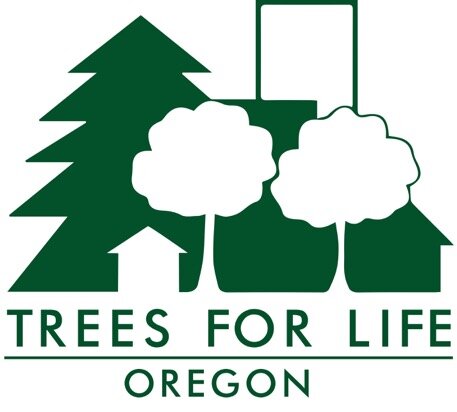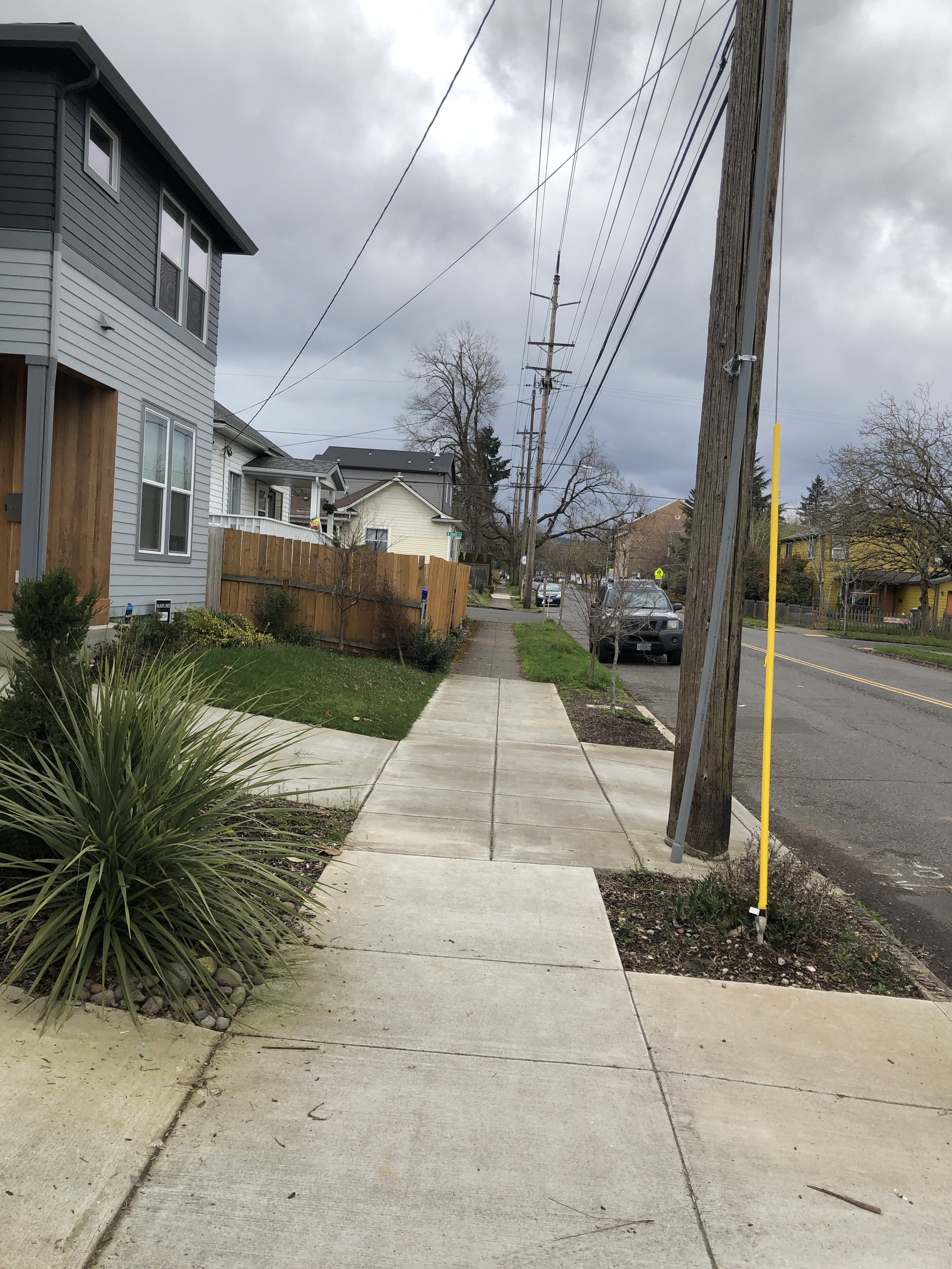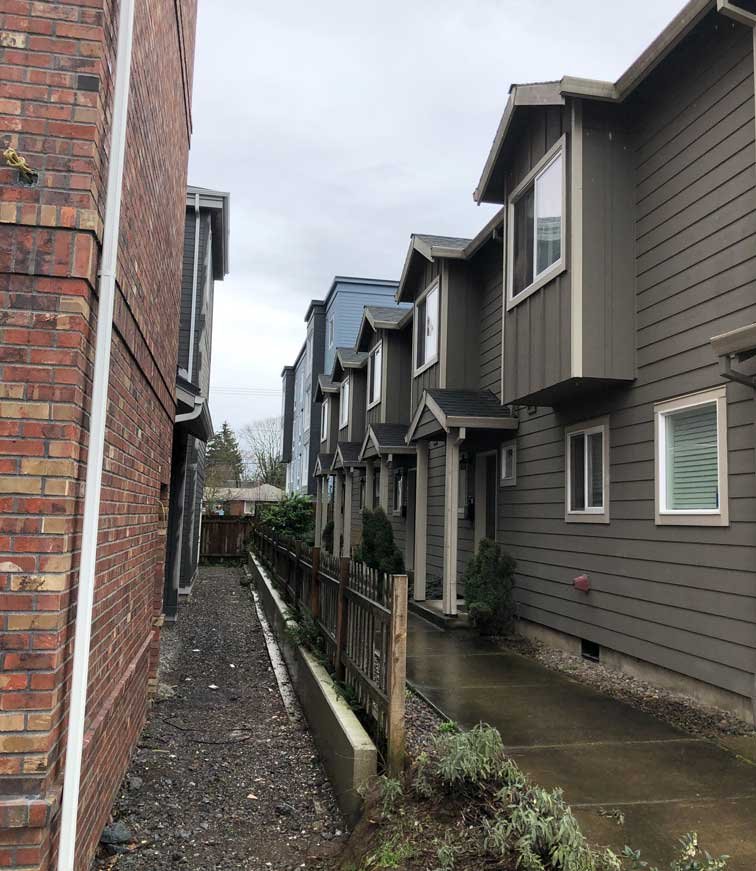A lack of defined and protected right-of-way planting strips, here shown in Brentwood-Darlington, results in a space often dominated by vehicular uses, as seen by these tire ruts in the very area where trees are supposed to be planted.
Overhead wires and a narrow planting strip mean no large- or medium-form tree will be possible in front of this multi-unit building under construction in Arbor Lodge. The City could have insisted that in such situations the developer leave room for at least one large-form tree in front of the building on one corner in exchange for adding a unit on another floor. But such improvements to the livability of new housing units almost never occurs, condemning future residents and those who already live on such fast-infilling streets to nearly treeless blocks that are more polluted, noisier, and much hotter than they would be if space for a few large-form trees had been required.
This yard and planting strip could accommodate a medium to large tree but there is none. Elderly and low-income homeowners often are afraid to have trees because the City won't pay for the maintenance of street trees and they can't physically do the work or afford to pay others.
No room for a sizeable tree around this newly constructed north Portland home! Not on either side nor in the front yard, more than half of which will be paved driveway and walkway. The neighbor’s tree will be nice to look out on unless the next-door lot is turned into a multiplex, precluding space for medium- or large-form trees. Residents of this block will have no shade from street trees either if redevelopment comes with curb planting strips less than four-feet wide, as is becoming the norm. Small to no trees are required for small planting strips.
The original right-of-way planting strip width can be seen in the background. Inexplicably, the builder of the new house in the middle got away with narrowing that strip, making it unsuitable for even a small tree. The City should be requiring developers to match planting strip widths, or where feasible enlarge them so they can accommodate street trees.
These newer single-family homes in Brentwood-Darlington have none of the mature Douglas-firs that have been a hallmark of this SE neighborhood. Nor do they have space to grow a medium- or large-form tree in the future. Without room for yard trees, entire blocks are reduced to relying on street trees for shade. But many streets in traditionally underserved areas have no defined right-of-way or have only undersized planting strips that preclude large or medium-form trees, even absent power lines.
With no space reserved for trees on the lot of this Vernon duplex, its residents’ only shade will come from a single street tree planted in a well. Tree wells are required to be a bit larger than in the past but are still too constrained to promote root growth. Often a tree then must be removed years before its natural decline. This robs residents of its health and environmental benefits just as it becomes mature enough to yield them. Duplexes, triplexes, and quadruplexes like this one, built right up to the sidewalk and surrounded by impervious surfaces, demonstrate a failure to design for climate.
As infill proceeds in St. Johns, the diverse lushness and large trees are being replaced with fewer and smaller trees and no yard trees to speak of. The neighborhood is living on borrowed canopy that is slowly being depleted and replaced with an inferior canopy.
Many Portland bus stops are completely paved over with impervious concrete or asphalt with no space for trees to provide shade for riders waiting for a bus. Trees near bus stops do face severe pruning streetside to accommodate passing buses. But for a city that likes to celebrate innovative design it seems to have thrown in the towel on thinking how to get trees into the transit mix for the benefit of riders and neighborhoods.
Portland planners hope that as more people crowd into the city, they will be persuaded to take buses and other mass transit. Lack of tree shade at bus stops like this one at SE Duke and 60th is a deterrent to taking a bus on hot days, which are increasingly common here, even in spring and fall.
Where planting strips are narrow, as in many lower income areas, the new high-density streetscapes are starkly lacking in space for large- or medium-sized trees. This Arbor Lodge street is a glimpse into the future of what your block may soon look like. Can the City really be deliberately planning to make all of Portland this unhealthy for mind, body, and spirit?
Across neighborhoods we see Portland's history and character disappearing in front of us. A tide of new buildings leaving no space for trees is replacing small, historic houses. When the house here is razed for development this enormous, unprotected shade tree will no doubt be removed.
The house on the right at least has potential for a large-form tree. That potential has been lost for the multi-unit building on the lot to the left.
Is this view next door in your future? If you live in a neighborhood of lower priced homes, it certainly could be. Expect zero trees next door since narrow setbacks can’t accommodate trees and still allow access to the back of these units.
If residents of these new buildings want to see trees of any kind they'll have to go for a walk. Their view, like that of a growing number of Portlanders, is the walls and windows of the building next door. Treeless properties like this are where many residents have had to spend month after month during the pandemic.
A brick facade makes this multi-unit building in Arbor Lodge pleasant and likely to remain so long after many other new projects will look tired and worn, and the new sidewalks are a plus. But where are the street trees? No room was left on the lot itself for trees, as the building was allowed to come right to the street.
New density results in front yards with room for only a small tree, if that. An alternative would be to focus on planting large trees on the curb strip. But with right-of-way planting strips like this one that are less than 4 feet wide, only small trees can be planted. Small trees can't provide the shade, cooling, and other environmental benefits that large-form trees do at maturity. One option for such disadvantaged neighborhoods would be for the City to require an adjustment to enlarge the strip to at least 6 feet--absent overhead power lines--to house large-form trees. This might require narrowing the sidewalk by 6 to 12 inches while still meeting minimum width standards.
Welcome to impermeable Portland! After millions spent to build a bigger stormwater drainage system, the City continues unabated to pave over the soil that absorbs rainfall runoff for free.
One good thing about new development in Portland neighborhoods with incomplete street infrastructure is that sidewalks and curbs were required to be put in. This promised that allowing infill or major remodels would eventually give pedestrians safer places to walk, and street trees would have defined planting spaces in which to thrive. Neither of those promises were fulfilled here. No sidewalk or curb was put in. Without a defined planting space for a street tree, planting is inadvisable. The planting strip is now parked on by vehicles. Pedestrians must walk in the mud, diverting into the street to walk around parked vehicles. Lack of sidewalks is a health equity issue. Neighborhoods with complete sidewalk systems make walking safer, encouraging more people to walk, which contributes to better health. Where sidewalks are absent the reverse is true. So why are developers sometimes allowed to skip adding them in front of their projects?
This newly constructed multiplex doesn’t have enough room for a tree so the builder simply paved it, creating an impermeable surface almost all around the complex. How will this reduce flooding when we have more intense rain events, which climate scientists are predicting? And with narrow planting strips up and down this street in Boise-Eliot, once the last old houses are demolished to make way for more of these units, the street will no longer have any large yard trees to help shade and cool it.
Large-form trees are often found in Portlanders' backyards. One threat to them comes from encouragement to build Auxiliary Dwelling Units (ADUs). These provide rental income for homeowners and more places for renters. The yard space now being gobbled up by ADUs, however, was once a prime spot for large shade trees. The result? More places to live but less livable places. Without those trees we’re left with more noise and less shade, pollution filtration, and rainfall interception. At the same time we’ve got more impermeable surfaces like roofs, driveways, and paved paths.
For now there are still enough modest-sized homes in Portland's formerly single-family residential neighborhoods to lull people into thinking that the livability of these areas will persist. It's easy to imagine their yard trees will continue to offer shade, places for birds to perch, and relief from staring all day into computer and phone screens.
But as infill proceeds to maximize the buildable footprint of each lot, adequate space for large trees is not being saved. And that is radically altering the character of these neighborhoods that drew people to them in the first place. Here is future Portland, a future where trees have been denied adequate space and are relegated to tiny setbacks. People will have to make do with dwarf trees or none visible from their window. Gone will be the soaring oaks, tulip trees, sycamores, lindens, maples, beeches, and native Douglas-firs.
Our canopy of large-form trees will shrink to scattered oases in increasingly overcrowded parks or in wide planting strips in a few lucky higher-income neighborhoods.
Newer homes larger than the ones they replaced are maxing out the buildable footprint so that the front doors are only 10 feet from the sidewalk. Reduced front yards allow for only one small-at-maturity tree. These token trees are becoming ubiquitous in developed areas. In 50 years these trees will still be shorter than the houses and unable to provide shade to roofs or parking spaces. This block was not planned well for a warming planet, as it will lack enough shade to blunt the impact of hotter temperatures coming our way.
























